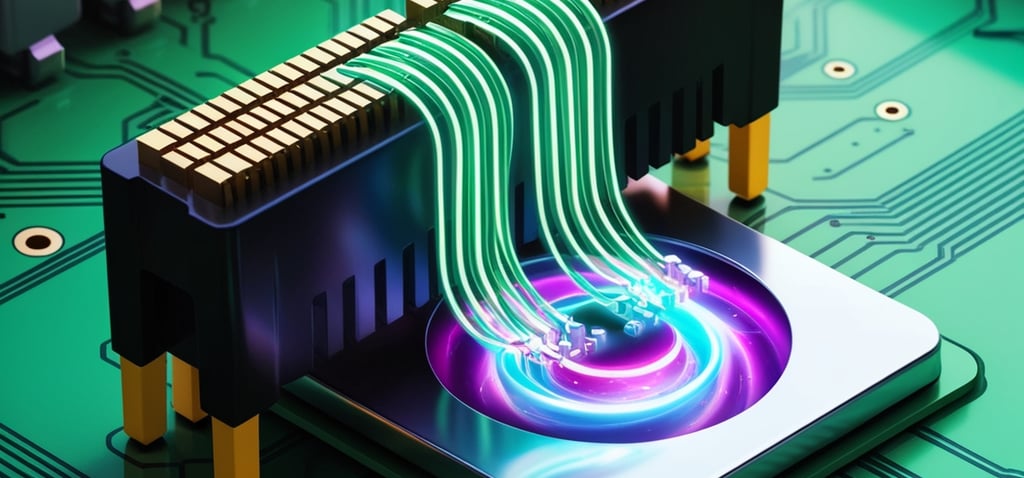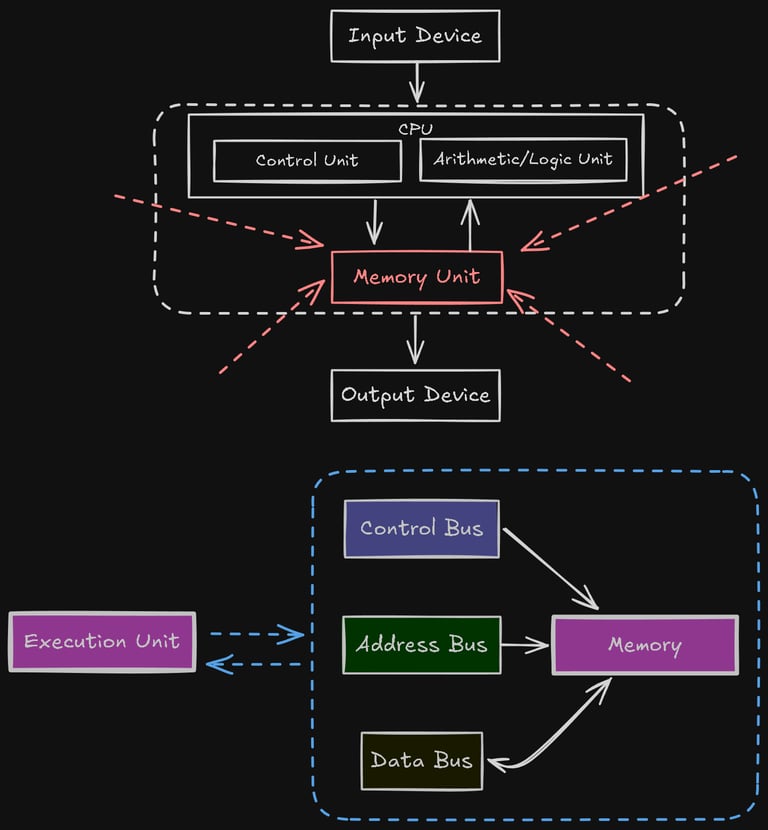The Digital Backbone: Memory's Invisible Influence
Memory Matters #1


In the intricate world of computing, where processors and graphics cards often steal the spotlight, there's an unsung hero working tirelessly behind the scenes: computer memory. This crucial component plays a pivotal role in shaping our digital experiences, yet its importance is often overlooked. Over the years, we've witnessed the fascinating evolution of main memory in computer architecture. For far too long, memory has been overshadowed by the flashy advancements in processors and graphics cards. But make no mistake - memory is the silent workhorse that has been quietly shaping the landscape of modern computing.
For decades, the focus of computer architecture was primarily on improving processor speeds. Moore's Law, a principle in the electronics industry, outlines that computational power approximately doubles biennially as costs decline, fueling swift technological progress. This phenomenon propelled the continuous advancement of CPU capabilities and process node reduction, even as memory technologies grappled to match this rapid pace of development. This imbalance led to an ever-widening gap between processor and memory speeds, often referred to as the "Memory Wall."
The Brain's Working Space: Understanding the Role of Memory
Imagine the CPU as a lead chef in a high-end restaurant, with DDR memory served as a team of skilled sous chefs. The computer system hums with activity as orders (data requests) pour in. Double Data Rate memory, store incoming requests for access. Memory channels add to this notion of multiple prep stations populated, where more stations (dual, quad or more setups) allow for parallel access, significantly boosting overall efficiency. The lead chef (CPU) calls out orders, and the sous chefs (DDR memory) respond swiftly, their speed (data transfer rates) crucial for the kitchen's performance.
Just as a kitchen's output depends on the team's expertise and the sous chefs' speed and coordination, a computer's performance relies on the seamless interaction between the CPU and DDR memory. This culinary dance, happening billions of times per second, determines how quickly your computer can serve up everything from simple spreadsheets to complex 3D renderings, making the difference between a Michelin-star performance and a slow, frustrating dining experience.
Imagine the memory of your computer as the brain's working space. Just as our minds need a place to process information and perform tasks, computers rely on memory as their cognitive playground. This is where data is temporarily stored, manipulated, and accessed at lightning speeds. Memory serves as the bridge between the processor and storage devices, enabling rapid data retrieval and manipulation. Without sufficient memory, even the most powerful processor would struggle to perform efficiently, much like how a brilliant mind would falter without adequate mental workspace.
Impact on System Performance and User Experience
The significance of memory becomes apparent when considering its impact on system performance and user experience:
Speed and Responsiveness
Application Load Times: With ample memory, applications launch faster as more data can be preloaded and readily available.
Multitasking Capabilities: Memory allows multiple applications to run simultaneously without significant slowdowns, enabling efficient multitasking.
Data Processing Capacity
Handling Large Datasets: Memory determines how much data can be processed at once, crucial for tasks like data analysis or scientific regressions.
Complex Calculations and Simulations: Memory enables the quick execution of intricate calculations and simulations, vital in fields like engineering, finance, and scientific research.
User Productivity
Reduced Wait Times: Adequate memory minimizes lag and waiting periods, allowing users to work more efficiently.
Smoother Workflow: With sufficient memory, transitions between tasks and applications become seamless, enhancing overall productivity.
A Brief History of Memory Evolution
There is a rich history surrounding the evolution of DDR memories (https://www.synopsys.com/blogs/chip-design/ddr-generations-memory-density-speed.html). Ever since the introduction of Double Data Rate (DDR) SDRAM in 2000, this technology has made significant progress in terms of frequency, speed, and efficiency. Improved speed of random access memory (RAM) has a positive impact on the overall performance of other computer components as well. Therefore, upgrading your RAM is an excellent way to boost the speed of a slow PC.
Semiconductor Revolution
The semiconductor revolution, which had a profound impact on the field of computer memory, led to the development of two important types of memory: Static RAM (SRAM) and Dynamic RAM (DRAM). SRAM, known for its speed, was primarily utilized for small quantities of high-speed storage, think cache, despite its high cost. On the other hand, DRAM, being more cost-effective, gradually became the standard for main memory, marking a significant milestone in the evolution of computer memory technology.
Modern Era
In the modern era, memory technology has continued to evolve at a rapid pace, bringing about significant advancements and improvements. One notable development has been the introduction of different generations of DDR RAM (DDR - DDR5). Each new generation has brought about remarkable enhancements in terms of speed and efficiency, allowing for faster and more efficient data processing. Moreover, the advent of non-volatile memory technologies, such as NOR/NAND flash, has revolutionized the way data is stored, providing greater reliability and durability. These advancements in memory technology have played a crucial role in shaping the digital landscape and enabling the seamless functioning of various devices and systems. The table below is a base example of frequency increases and power decreases as the technology evolves.
The Memory Bottleneck and Ongoing Efforts
Despite the remarkable advancements in computing, the persistent obstacle known as the "memory wall" remains a significant challenge. The term "memory wall" refers to the widening disparity between the speeds of processors and memory. As a result, much of the potential performance gains from faster processors were negated by the time spent waiting for data to be fetched from memory.
As common as engineering debug-hooks, Compute Walls are a reality architects face in todays ecosystem (we will touch on that in a future snip). To address this limitation, ongoing endeavors have focused on innovative solutions such as the 3D stacking of memory chips via Thru-Silicon-Vias, the additional of memory channels, and enlarging the Data IO width as using on High Bandwidth Memory (HBM) among other architectural feats.
Memory’s Role in Emerging Technologies
As we move into the future, memory plays a crucial role in enabling cutting-edge technologies:
Artificial Intelligence and Machine Learning: These data-hungry applications require vast amounts of high-speed memory.
Big Data Analytics: Processing and analyzing massive datasets in real-time demands advanced memory solutions.
Internet of Things (IoT): Efficient, low-power memory is essential for the billions of connected devices.
The Future of Memory Technology
Recent advancements are pushing the boundaries of what’s possible with computer memory:
Universal Memory: Researchers at Stanford have developed a new phase- change memory using GST467, an alloy of germanium, antimony, and tellurium. This technology promises to combine the speed of RAM with the non-volatility of storage, potentially revolutionizing computer architecture.
Advanced DRAM: Memory vendors are pushing DRAM technology to new limits, with plans to scale down to single-digit nanometer nodes by 2030. A reduction of scaling has power optimization benefits however also imposes challenges related to Signal Integrity and Fault occurrences.
3D DRAM: Vertical stacking technologies are being developed to increase memory density and performance.
EUV Lithography: The adoption of Extreme Ultraviolet Lithography is enabling the production of smaller, more efficient memory chips.
As technology continue to advance and reach higher levels of maturity, we can anticipate a future where computers not only exhibit increased speed, but also possess enhanced capabilities that enable them to effectively tackle the intricate and demanding tasks that lie ahead.
Memory is indeed the unsung hero of computing, playing a critical role in every aspect of our digital lives. As we continue to push the boundaries of what’s possible with computers, from AI to big data analytics, the importance of memory grows. Next time you marvel at the speed of your computer or the complexity of tasks it can handle, remember to give a nod to the silent force working tirelessly behind the scenes – your computer’s memory. It truly is the key to unlocking the full potential of our digital world.
Come with us as we continue to explore. Next Up: RAM v. ROM Differences
Linked to ObjectiveMind.ai for increased content distribution.






